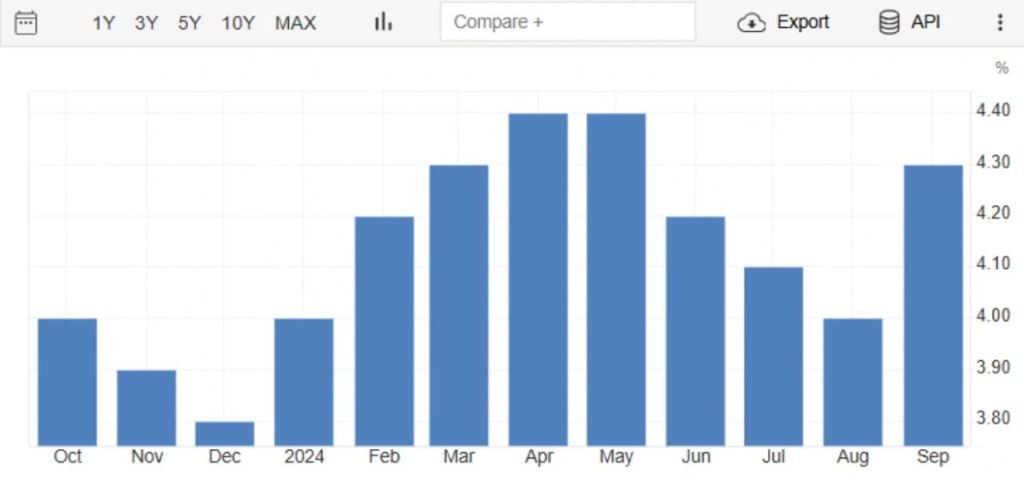
UK Unemployment Rate Rises to 4.3% in Q3 2024: Analyzing the Economic Landscape
The United Kingdom’s unemployment rate has climbed to 4.3% for the three months from July to September 2024, up from 4.0% in the preceding quarter. This marks the highest unemployment rate since the three-month period ending in May 2024, exceeding market expectations of 4.1%. The increase in unemployment was primarily driven by a rise in the number of individuals unemployed for up to six months, with a continued uptick in the number of people unemployed for longer than six months as well. These factors highlight potential challenges in the labor market, suggesting that some segments of the workforce may be facing longer periods of joblessness.

Factors Behind the Rise in Unemployment
The increase in unemployment reflects a complex set of factors. The biggest contributor has been a rise in short-term unemployment, with individuals out of work for less than six months seeing an uptick in numbers. This suggests that while some workers may have lost jobs due to economic fluctuations, they are having a harder time finding new positions in a rapidly changing job market. Additionally, the continued rise in long-term unemployment — people out of work for over six months — points to persistent structural issues in the labor market, which could include skills mismatches, economic slowdowns, or sector-specific challenges.
However, it’s also important to consider that these shifts may be cyclical and influenced by short-term economic conditions such as inflation, interest rate hikes, or global economic disruptions. A deeper understanding of the root causes behind the increase in unemployment will be necessary to assess the long-term health of the UK labor market.
Positive Employment Trends: Full-Time Employment on the Rise
In contrast to the rise in unemployment, the overall number of employed individuals saw a significant increase during the same period, growing by 220,000 to a total of 33.31 million. This increase was primarily driven by the growth in full-time employment, which is a positive sign for the overall economy. More people securing full-time jobs reflects a degree of job market stability and the potential for longer-term economic growth. Full-time employment is often seen as a sign of a healthier labor market compared to part-time or temporary work, which can be more vulnerable to economic shocks.
The increase in full-time employment suggests that businesses may be looking to stabilize their workforce and invest in longer-term talent. However, while the growth in full-time positions is encouraging, it is worth noting that these gains are not enough to fully offset the increase in unemployment rates, signaling that challenges remain within certain sectors and demographics.
Decline in Second Jobs and Steady Economic Inactivity Rate
One interesting trend observed during this period was a decline in the number of people holding second jobs. As of the most recent data, those with second jobs accounted for 3.7% of all employed individuals, down from previous periods. This decline may be due to several factors. First, people may no longer feel the need to take on second jobs, possibly due to improved full-time employment prospects or the rising cost of living. Additionally, with more people finding stable full-time roles, fewer individuals may be seeking supplemental income sources.
At the same time, the economic inactivity rate, which measures the proportion of the working-age population neither employed nor actively looking for work, held steady at 21.8%. This unchanged rate suggests that, while some individuals are entering the job market, others remain on the sidelines due to factors such as retirement, illness, family care responsibilities, or education. The relatively stable inactivity rate indicates that, despite some improvements in full-time employment, there is still a significant portion of the population that is disengaged from the workforce.
Implications for the UK Labor Market: Opportunities and Challenges Ahead
The UK labor market presents a mixed picture, with unemployment rising and employment continuing to grow in certain areas, particularly full-time roles. The fact that unemployment has risen despite an increase in overall employment points to a disconnect between the growth in job opportunities and the ability of some workers to secure them. This could be attributed to a number of structural issues, such as skills mismatches, geographical imbalances between job vacancies and job seekers, or the ongoing impacts of inflation and economic policy changes.
The decline in second jobs may also suggest that many workers are prioritizing full-time, stable employment over multiple part-time or temporary roles. While this trend is generally positive, it also highlights the increasing pressure on households to maintain their living standards, which could become unsustainable if inflationary pressures continue.
Looking ahead, the UK’s labor market will likely face a combination of challenges and opportunities. Policymakers will need to focus on addressing the rise in unemployment through targeted interventions, such as upskilling programs, incentives for businesses to hire long-term unemployed individuals, and strategies to reduce the barriers to workforce participation. The growth in full-time employment is encouraging, but the rise in both short-term and long-term unemployment underscores the need for careful monitoring and intervention to support those facing difficulties in the labor market.
Ultimately, the trajectory of the UK labor market will depend on broader economic conditions, including inflation, economic growth, and government policies aimed at supporting both workers and businesses. While some positive trends are emerging, particularly in full-time employment, challenges remain, and the economic landscape will need careful management to ensure continued growth and stability.
Share
Hot topics

Federal Reserve’s Challenges to Trump’s New Policies
As the Federal Reserve Open Market Committee (FOMC) prepares for its upcoming meeting, all eyes are on how the Fed will respond to Donald Trump’s latest economic policies. With the...
Read more




Submit comment
Your email address will not be published. Required fields are marked *